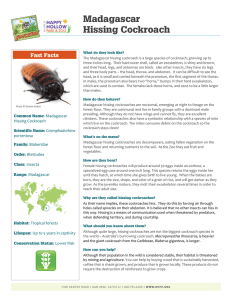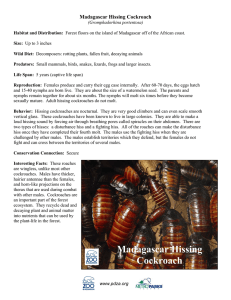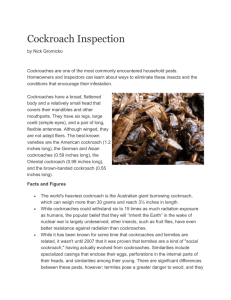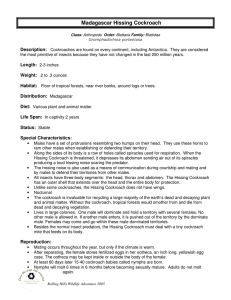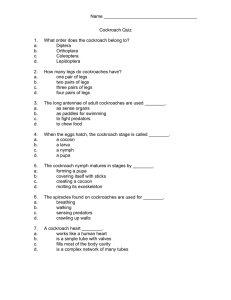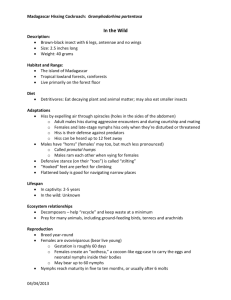Cockroaches: Fact or Fiction?
advertisement
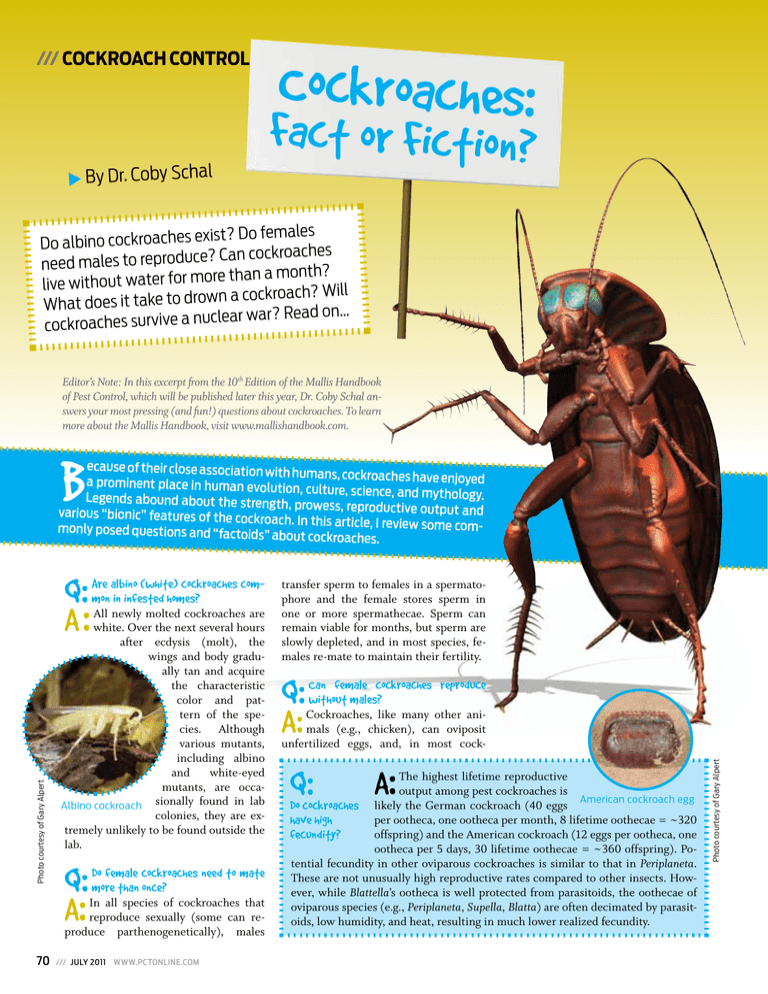
/// COCKROACH control By Dr. Coby Schal Cockroaches: Fact or Fiction? ist? Do females Do albino cockroaches ex ? Can cockroaches need males to reproduce e than a month? live without water for mor n a cockroach? Will What does it take to drow clear war? Read on… cockroaches survive a nu Editor’s Note: In this excerpt from the 10th Edition of the Mallis Handbook of Pest Control, which will be published later this year, Dr. Coby Schal answers your most pressing (and fun!) questions about cockroaches. To learn more about the Mallis Handbook, visit www.mallishandbook.com. B ecause of their close association with humans, cockroaches have enjoyed a prominent place in human evolutio n, culture, science, and mythology. Legends abound about the strength , prowess, reproductive output and various “bionic” features of the cock roach. In this article, I review some commonly posed questions and “factoid s” about cockroaches. Photo courtesy of Gary Alpert A: Are albino (white) cockroaches common in infested homes? All newly molted cockroaches are white. Over the next several hours after ecdysis (molt), the wings and body gradually tan and acquire the characteristic color and pattern of the species. Although various mutants, including albino and white-eyed mutants, are occaAlbino cockroach sionally found in lab colonies, they are extremely unlikely to be found outside the lab. Q: A: Do female cockroaches need to mate more than once? In all species of cockroaches that reproduce sexually (some can reproduce parthenogenetically), males 70 /// JULY 2011 www.pctonline.com transfer sperm to females in a spermatophore and the female stores sperm in one or more spermathecae. Sperm can remain viable for months, but sperm are slowly depleted, and in most species, females re-mate to maintain their fertility. Q: A: Can female cockroaches reproduce without males? Cockroaches, like many other animals (e.g., chicken), can oviposit unfertilized eggs, and, in most cock- Q: A: The highest lifetime reproductive output among pest cockroaches is Do cockroaches likely the German cockroach (40 eggs American cockroach egg per ootheca, one ootheca per month, 8 lifetime oothecae = ~320 have high offspring) and the American cockroach (12 eggs per ootheca, one fecundity? ootheca per 5 days, 30 lifetime oothecae = ~360 offspring). Potential fecundity in other oviparous cockroaches is similar to that in Periplaneta. These are not unusually high reproductive rates compared to other insects. However, while Blattella’s ootheca is well protected from parasitoids, the oothecae of oviparous species (e.g., Periplaneta, Supella, Blatta) are often decimated by parasitoids, low humidity, and heat, resulting in much lower realized fecundity. Photo courtesy of Gary Alpert Q: /// ANNUAL COCKROACH CONTROL ISSUE roaches, these eggs are inviable. In some cockroaches, however, unfertilized eggs can develop into females only, and parthenogenetic reproduction can be sustained for several generations. Some cockroaches are facultatively parthenogenetic (e.g., American cockroach), and one, Pycnoscelus surinamensis, appears to be an obligatory parthenogen; males are not known in this species. Cockroaches’ life cycle includes going from an egg case to a nymph to an adult. Q: Q: Do all cockroaches form egg cases? Q: Are pathogenic microbes the most common associates of cockroaches? A: What are the largest and smallest adult cockroaches? The heaviest cockroach is probably Macropanesthia rhinoceros, the Australian rhinoceros cockroach. It is wingless, weighs up to 40 grams (1.4 oz), up to 8 cm long (3.1 inches) and lives more than 10 years. The longest cockroach is Megaloblatta blaberoides, which is about 4 inches (10 cm), head to wing tip. A common “pet” cockroach, Gromphadorhina portentosa (Madagascar hissing cockroach), is also quite large (Fig. 2-2, page 156). The Macropanesthia smallest adult is probrhinoceros ably Anaplecta, which lives in the tropical rainforests of Central America and weighs under 10 mg (0.0003 oz). Some of the phoretic and inquiline species (Attaphila, which lives with leafcutting ants) may rival Anaplecta’s small size, with a length of less than 3⁄16 inch (4 mm). Cockroach body mass thus ranges over 3.5 orders of magnitude. Q: A: Do all cockroaches fly? Most of the pest species do not fly, although adult males of the brownbanded cockroach (Supella longipalpa) can fly, as can adult male Periplaneta (American, Australasian). In Gulf Coast states, males of Blattella asahinae (Asian) and Panchlora nivea (Cuban) fly; in desert areas, male Arenivaga fly to lights; and throughout the U.S., males of various Parcoblatta species can fly. There are hundreds of tropical species in which both sexes fly. www.pctonline.com/use reader service #44 72 /// august 2011 www.pctonline.com A: Cockroach eggs are always packaged into oothecae. Some oothecae are thick and hard (American cockroach), some are thin and softer (German cockroach), and some have been reduced to a very thin membranous structure. In the family Blaberidae, a large clutch of eggs is contained within a very thin ootheca, extruded, rotated, and withdrawn into the uterus for incubation. One species (Diploptera punctata) does not make an oothecal case at all. A: Symbiotic intracellular bacteroids within bacteriocytes (fat body cells) are highly abundant. They are vertically transmitted on or in the egg from the mother to her offspring, and they play important roles in the production of vitamins and other nutritional cofactors. Methanogenic and other microbes also live obligately in the hindgut of cockroaches. Pathogenic microbes may be common in cockroaches, but in much smaller numbers, and only when the cockroach is closely associated with human or animal excrement, as in sewer systems and livestock barns. Q: Are all cockroaches active only at night? A: All pest cockroaches are nocturnal, but some forest cockroaches are active during the day. Some are dazzlingly colorful, and some are wasp mimics, a feature useful only during the day. /// continued on page 77 COCKROACH CONTROL ISSUE /// Q: A: How long can cockroaches live without food or water? The 4,500 cockroach species are exceptionally diverse. While most small cockroaches can live up to several weeks without food, and a week without water, large species (e.g., Blaberus) are much hardier. Some desert cockroaches (e.g., Arenivaga) can withstand long periods without water. /// continued from page 72 Q: A: How long can a cockroach live without its head? Large blaberid species can live “headless” for a month or longer. The German cockroach can be maintained for a week without its head. Decapitation results in death because of infection, or sepsis, from invasion of the hemocoel by gut microbes, and water loss, either from bleeding or water evaporation from the cut surface. Their open circulatory system in almost all habitat types where insects occur. Many of the Polyphagidae (e.g., Arenivaga) inhabit desert regions of North Africa, Asia, and the U.S. Southwest. Some epilamprines are amphibious in streams, pools and in ephemeral waterfilled bromeliads. Some species live in leaf-litter, dead leaves trapped above ground, in caves, hollow trees, rotting logs, in nests of other animals, flowers, at various altitudes, and, of course, in homes. Cockroaches are also found in the grasslands of the Siberian steppes where temperatures can range from 40°C (104°F) in summer to -40°C (-40°F) in winter. Q: A: How long can a cockroach survive being submerged in water? Two physiological systems come into play here. The respiratory system of the cockroach consists of segmental spiracles that lead to trachea, which divide and subdivide to tracheoles which exchange gases with cells. The metabolic rate determines how much oxygen is consumed — more is consumed at Some features of the cockroach, Periplaneta americana, is shown. (A) head, (B) tarsal segments, (C) tarsus showing claws and arolium, (D) underside of adult female, and (E) adult male, showing both cerci and styli. functions under low blood pressure, and rapid coagulation results in relatively low blood loss. Breathing occurs through spiracles and trachea. Moreover, coordination of many neural functions is decentralized to thoracic and abdominal ganglia, so the head is dispensable — until it is time to eat! To maximize longevity of a decapitated cockroach, tie off the head with a tourniquet, severe the head anterior to the knot, and maintain the cockroach at low temperature and high humidity. Q: Do cockroaches occur in all habitats on earth? A: Cockroaches are ubiquitous higher temperatures. Some species of cockroaches live in water pools that accumulate at the base of bromeliads. These species (e.g., Epilampra) can remain submerged for longer than 15 minutes. Also, there are species that live at the edge of lakes, rivers, and lagoons, and they too can remain submerged for long periods of time. The German cockroach can survive 15 minutes submerged in cold tap water, but succumbs quickly to warm water. The American cockroach is known to occasionally traverse through sewer lines and toilet traps, so it too can survive submerged for at least several minutes. Q: A: Can all cockroaches walk up walls and upside down on ceilings? Cockroaches use a combination of pretarsal arolia that serve as sucwww.pctonline.com august 2011 /// 77 www.pctonline.com/use reader service #45 /// ANNUAL COCKROACH control ISSUE tion cup-like devices, and tarsal pulvilli, which create friction with surfaces, for upward, downward, and upside-down walking (see images above). These devices, together with the pretarsal claws, allow cockroaches to grip smooth and rough surfaces. But some cockroaches do not have arolia, severely limiting their ability to walk on smooth surfaces. Q: Why do cockroaches die on their backs with their legs up? A: Neurotoxic insecticides cause tremors and muscle spasms, flipping the cockroach on its back. A healthy cockroach can easily right itself, but without muscle coordination, the cockroach dies on its back. Cockroaches exposed to slow-acting insecticides that target respiration (energy production) also can die “face-down,” as they run out 78 /// JULY 2011 www.pctonline.com of energy without experiencing muscle spasms. Q: A: Are cockroaches more resistant to radiation than other insects? Arthropods are more able to withstand gamma radiation than vertebrates because their cells divide less and do so synchronously at each molt cycle. Arthropods also have less rapidly dividing tissue, such as bone marrow, which is more sensitive to radiation. However, cockroaches have received substantial undeserved attention in the popular press for their prowess at withstanding radiation, in large part due to depictions of “the last roach standing” after a nuclear holocaust (e.g., “The Day After,” ABC-TV 1983 ). In fact, cockroaches generally are far inferior to other insects in withstanding radiation. Willard and www.pctonline.com/use reader service #46 Cherry (1975) concluded that 15,000 rads of gamma radiation from a Cobalt-60 source reduced the life expectancy of six species of irradiated moths by 7-33%, but life expectancies of six cockroach species were reduced by about 90%. Surprisingly, the hardy American cockroach was most sensitive to radiation, and the brownbanded cockroach was least affected by radiation. In a recent episode of “MythBusters” (http://kwc.org/mythbusters/2008/01/ plane_on_a_conveyor_belt.html), a 30day test concluded that cockroaches “are quite hardy, able to survive radiation doses at 10,000 rads, which is 10X the lethal dose for humans. However, the flour beetles did much better and the fruit flies might have done better if their normal lifespan wasn’t 30 days.” Myth busted!

